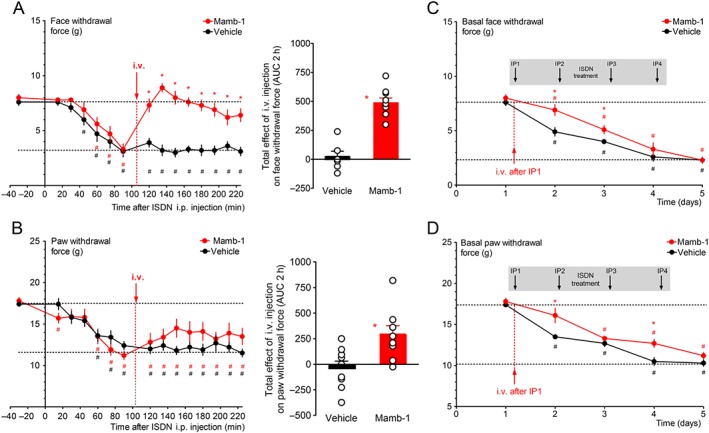Figure 2.

Reversal of ISDN‐induced cephalic and extra‐cephalic acute mechanical allodynia by an i.v. injection of mambalgin‐1. (A, B – left panels) Kinetics of the anti‐allodynic effect on face (A) and paw (B) mechanical withdrawal thresholds (g) of an i.v. injection of Mamb‐1 (11.3 nmol·kg−1) 105 min after the i.p. injection of ISDN in rats. Mean ± SEM, n = 9: *P < 0.05 compared to vehicle with Mann–Whitney non‐parametric test; # P < 0.05 compared to control value before ISDN injection with Wilcoxon matched paired test. (A, B ‐ right panels) Total effect of i.v. Mamb‐1 (or vehicle) on face (A) and paw (B) withdrawal force calculated as the AUC during the 2 h after the i.v. injection. Individual data points and mean ± SEM, n = 9, *P < 0.05 compared to vehicle with Mann–Whitney non‐parametric test. (C, D) One i.v. injection of Mamb‐1 (11.3 nmol·kg−1) after the first ISDN injection, as shown in A and B, induces a delay in the subsequent generation of ISDN‐evoked chronic allodynia induced by three more daily ISDN injections. Basal face (C) and paw (D) mechanical withdrawal force (g) measured before each daily ISDN injection and the day after the last ISDN injection (day 5). Mean ± SEM, n = 9: *P < 0.05 compared to vehicle with Mann–Whitney non‐parametric test; # P < 0.05 compared to control before the first ISDN injection with Wilcoxon matched paired test.
